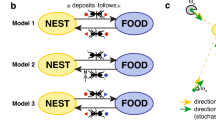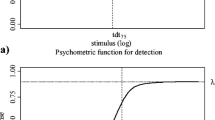Abstract
Here, we developed a multi-agent model to describe dynamical pattern formations using pheromones produced by each agent. We compared the balances between exploitation (one site is visited by many foragers) and exploration (many sites are visited by agents) of two algorithms. In both algorithms, agents linearly reacted to pheromone concentrations within their detection fields and changed detection fields depending on the differences between left and right pheromone concentrations. Thanks to this event, we succeeded in agents to produce ordered pattern formations at macro-levels even though each agent’s reactions to pheromones were set as linear reactions. However, agents could achieve more moderated pattern formations when they occasionally stopped changing detection fields by considering the relationship between global information (pheromone concentrations) and local information (moving directions of others).




Similar content being viewed by others
References
Aron S, Beckers R, Deneubourg JL, Pasteels JM (1993) Memory and chemical communication in the orientation of two mass-recruiting ant species. Insect. Soc. 40:369–380
Grüter C, Czaczkes T, Ratnieks FLW (2011) Decision making in ant foragers (Lasius niger) facing conflicting private and social information. Behav Ecol Sociobiol 65:141–148
Bolek B, Wolf H (2015) Food searches and guiding structures in North African desert ants. Cataglyphis. J Comp Physiol A. doi:10.1007/s00359-015-0985-8
Czaczkes TJ, Grüter C, Ratnieks FLW (2012) Negative feedback in ants: crowding results in less trail pheromone deposition. J Royal Soc Interface 10(81):1–6
Detrain C, Deneubourg JL (2006) Self-organized structures in superorganism: do ants ”behave” like molecule? Phys Life Rev 3:162–187
Goss S, Aron S, Deneubourg JL, Pasteels JM (1989) Self-organized shortcuts in the Argentine Ant. Naturwissenschaften 76:579–581
Deneubourg JL, Aron S, Goss S, Pasteels JM (1990) The self-organizing exploratory pattern of the Argentine ant. J Insect Behav 3–2:159–168
Perna A et al (2012) Individual rules for trail pattern formation in Argentine ants (Linepithema humile). Plos Compt Biol 8–7:1–12
Czaczkes TJ, Franz S, Witte V, Heinze J (2015) Perception of collective path use affects path selection in ants. Anim Behav 99:15–24
Author information
Authors and Affiliations
Corresponding author
Additional information
This work was presented in part at the 1st International Symposium on Swarm Behavior and Bio-Inspired Robotics, Kyoto, Japan, October 28–30, 2015.
About this article
Cite this article
Sakiyama, T., Gunji, YP. Moderated pattern formations on trail-laying foraging. Artif Life Robotics 21, 253–257 (2016). https://doi.org/10.1007/s10015-016-0293-6
Received:
Accepted:
Published:
Issue Date:
DOI: https://doi.org/10.1007/s10015-016-0293-6




